Case Study Analysis: COPD Patient Assessment, Plan, and Treatment
VerifiedAdded on 2021/04/24
|5
|822
|27
Case Study
AI Summary
This case study presents a patient admitted to the respiratory ward with severe dyspnea, fever, cough, increased sputum production, and dizziness. The patient, diagnosed with stage II COPD three years prior, is experiencing acute exacerbation of his condition. The case study details subjective data from the patient and his partner, objective findings including vital signs, respiratory assessment, and physical examination results. The assessment section highlights the patient's condition and potential risks. The plan outlines interventions such as positioning, oxygen administration, and medication. The assignment includes references to support the case study findings and recommendations. This case study provides a comprehensive overview of COPD management, including assessment, diagnosis, and treatment planning.
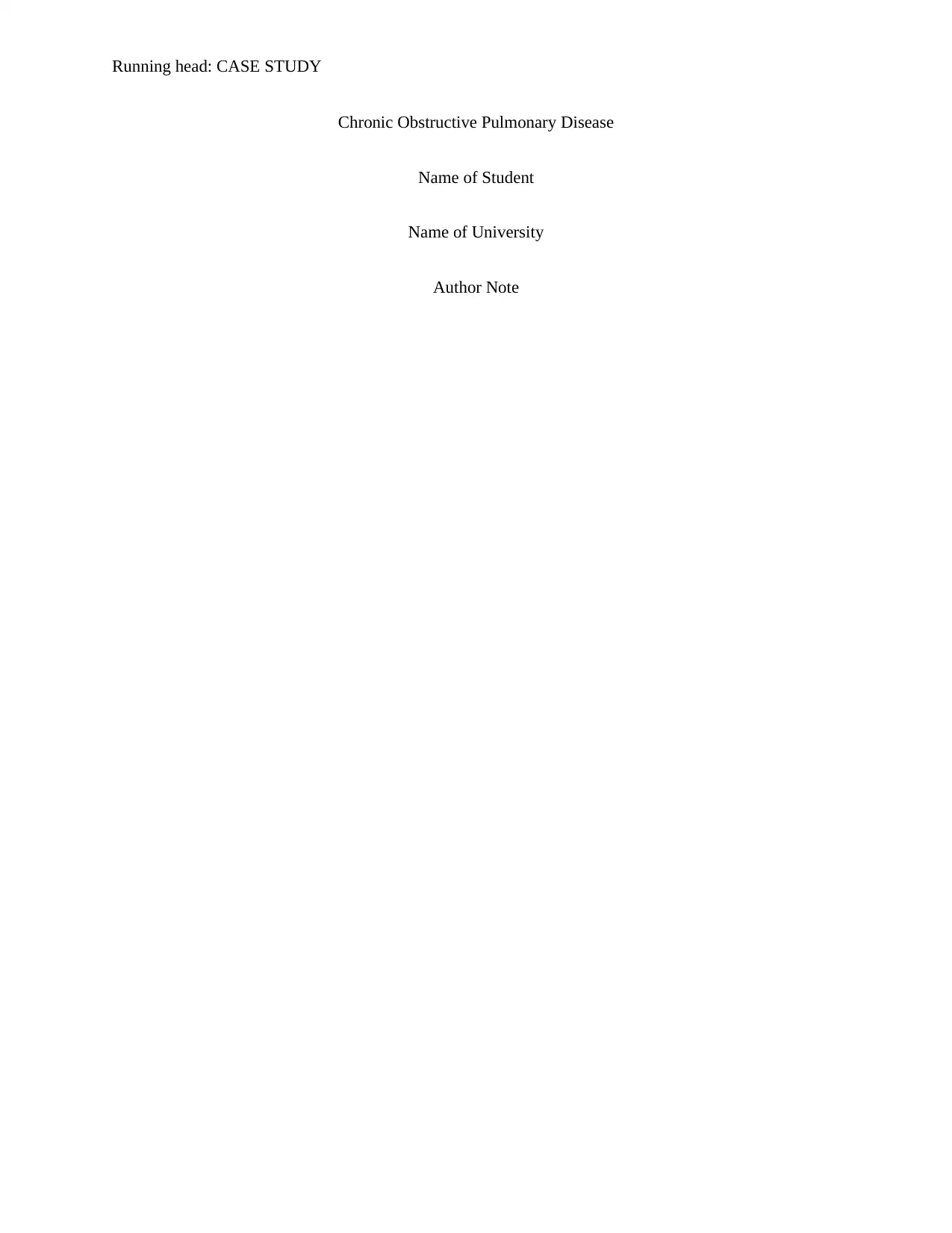
Running head: CASE STUDY
Chronic Obstructive Pulmonary Disease
Name of Student
Name of University
Author Note
Chronic Obstructive Pulmonary Disease
Name of Student
Name of University
Author Note
Paraphrase This Document
Need a fresh take? Get an instant paraphrase of this document with our AI Paraphraser
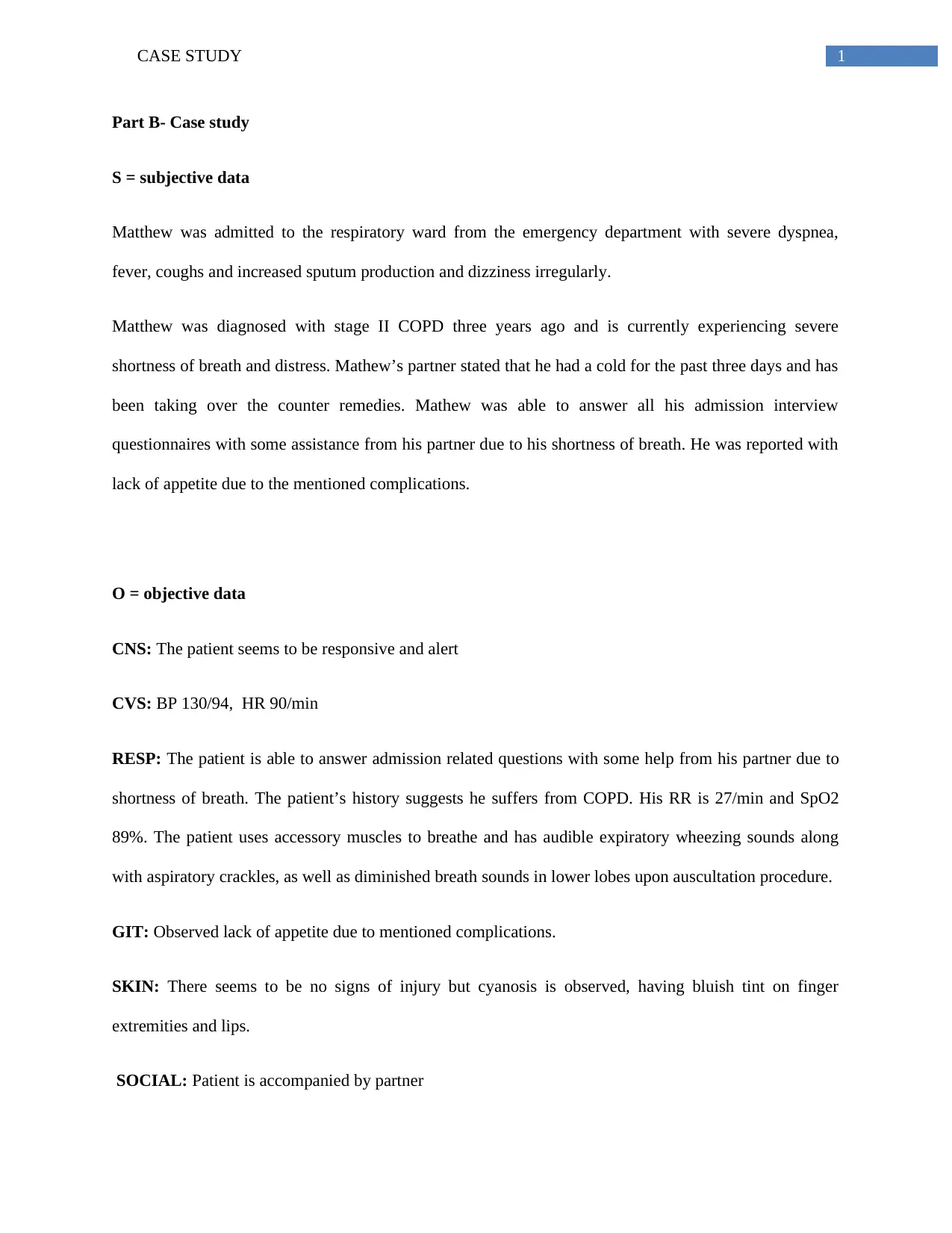
1CASE STUDY
Part B- Case study
S = subjective data
Matthew was admitted to the respiratory ward from the emergency department with severe dyspnea,
fever, coughs and increased sputum production and dizziness irregularly.
Matthew was diagnosed with stage II COPD three years ago and is currently experiencing severe
shortness of breath and distress. Mathew’s partner stated that he had a cold for the past three days and has
been taking over the counter remedies. Mathew was able to answer all his admission interview
questionnaires with some assistance from his partner due to his shortness of breath. He was reported with
lack of appetite due to the mentioned complications.
O = objective data
CNS: The patient seems to be responsive and alert
CVS: BP 130/94, HR 90/min
RESP: The patient is able to answer admission related questions with some help from his partner due to
shortness of breath. The patient’s history suggests he suffers from COPD. His RR is 27/min and SpO2
89%. The patient uses accessory muscles to breathe and has audible expiratory wheezing sounds along
with aspiratory crackles, as well as diminished breath sounds in lower lobes upon auscultation procedure.
GIT: Observed lack of appetite due to mentioned complications.
SKIN: There seems to be no signs of injury but cyanosis is observed, having bluish tint on finger
extremities and lips.
SOCIAL: Patient is accompanied by partner
Part B- Case study
S = subjective data
Matthew was admitted to the respiratory ward from the emergency department with severe dyspnea,
fever, coughs and increased sputum production and dizziness irregularly.
Matthew was diagnosed with stage II COPD three years ago and is currently experiencing severe
shortness of breath and distress. Mathew’s partner stated that he had a cold for the past three days and has
been taking over the counter remedies. Mathew was able to answer all his admission interview
questionnaires with some assistance from his partner due to his shortness of breath. He was reported with
lack of appetite due to the mentioned complications.
O = objective data
CNS: The patient seems to be responsive and alert
CVS: BP 130/94, HR 90/min
RESP: The patient is able to answer admission related questions with some help from his partner due to
shortness of breath. The patient’s history suggests he suffers from COPD. His RR is 27/min and SpO2
89%. The patient uses accessory muscles to breathe and has audible expiratory wheezing sounds along
with aspiratory crackles, as well as diminished breath sounds in lower lobes upon auscultation procedure.
GIT: Observed lack of appetite due to mentioned complications.
SKIN: There seems to be no signs of injury but cyanosis is observed, having bluish tint on finger
extremities and lips.
SOCIAL: Patient is accompanied by partner
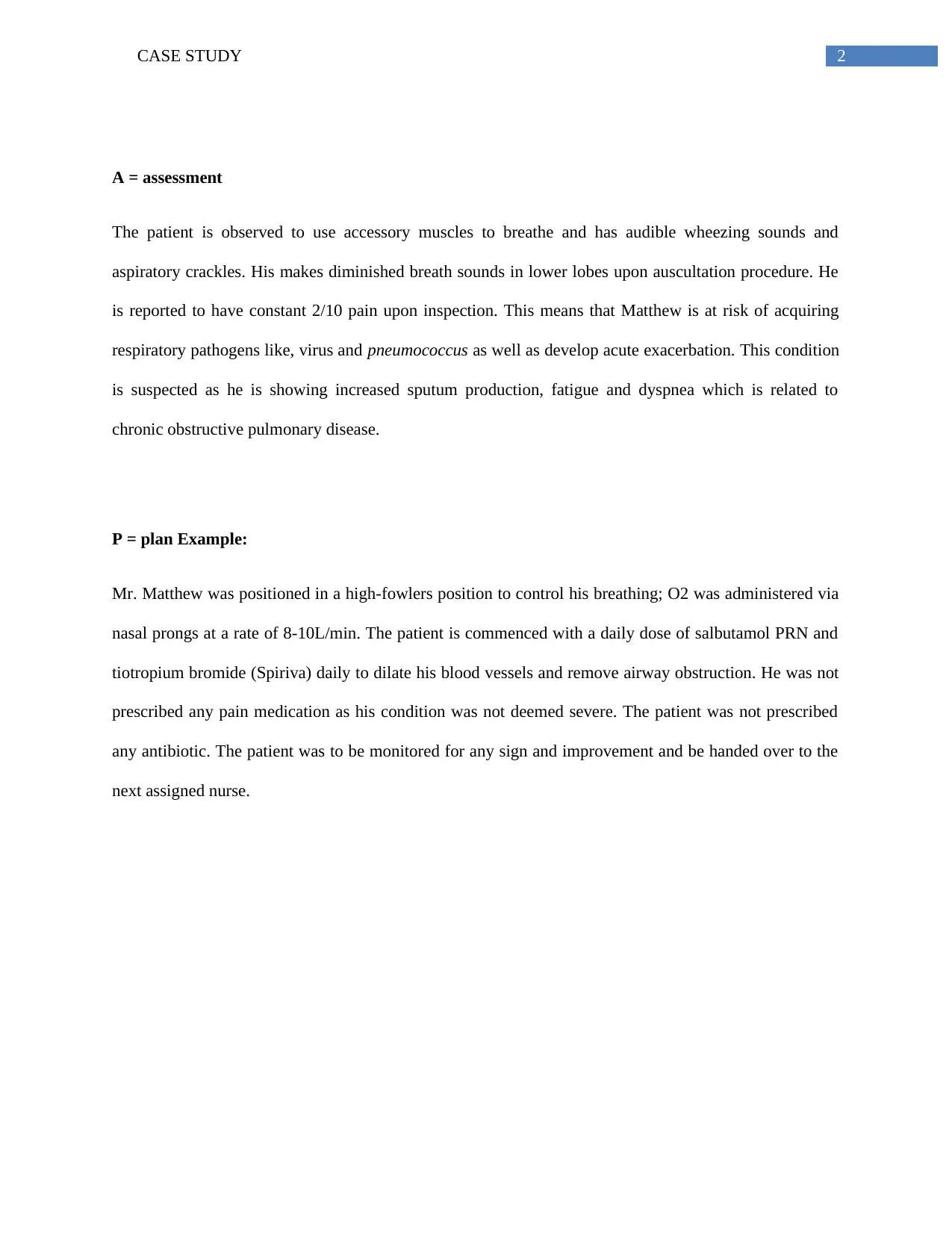
2CASE STUDY
A = assessment
The patient is observed to use accessory muscles to breathe and has audible wheezing sounds and
aspiratory crackles. His makes diminished breath sounds in lower lobes upon auscultation procedure. He
is reported to have constant 2/10 pain upon inspection. This means that Matthew is at risk of acquiring
respiratory pathogens like, virus and pneumococcus as well as develop acute exacerbation. This condition
is suspected as he is showing increased sputum production, fatigue and dyspnea which is related to
chronic obstructive pulmonary disease.
P = plan Example:
Mr. Matthew was positioned in a high-fowlers position to control his breathing; O2 was administered via
nasal prongs at a rate of 8-10L/min. The patient is commenced with a daily dose of salbutamol PRN and
tiotropium bromide (Spiriva) daily to dilate his blood vessels and remove airway obstruction. He was not
prescribed any pain medication as his condition was not deemed severe. The patient was not prescribed
any antibiotic. The patient was to be monitored for any sign and improvement and be handed over to the
next assigned nurse.
A = assessment
The patient is observed to use accessory muscles to breathe and has audible wheezing sounds and
aspiratory crackles. His makes diminished breath sounds in lower lobes upon auscultation procedure. He
is reported to have constant 2/10 pain upon inspection. This means that Matthew is at risk of acquiring
respiratory pathogens like, virus and pneumococcus as well as develop acute exacerbation. This condition
is suspected as he is showing increased sputum production, fatigue and dyspnea which is related to
chronic obstructive pulmonary disease.
P = plan Example:
Mr. Matthew was positioned in a high-fowlers position to control his breathing; O2 was administered via
nasal prongs at a rate of 8-10L/min. The patient is commenced with a daily dose of salbutamol PRN and
tiotropium bromide (Spiriva) daily to dilate his blood vessels and remove airway obstruction. He was not
prescribed any pain medication as his condition was not deemed severe. The patient was not prescribed
any antibiotic. The patient was to be monitored for any sign and improvement and be handed over to the
next assigned nurse.
⊘ This is a preview!⊘
Do you want full access?
Subscribe today to unlock all pages.

Trusted by 1+ million students worldwide
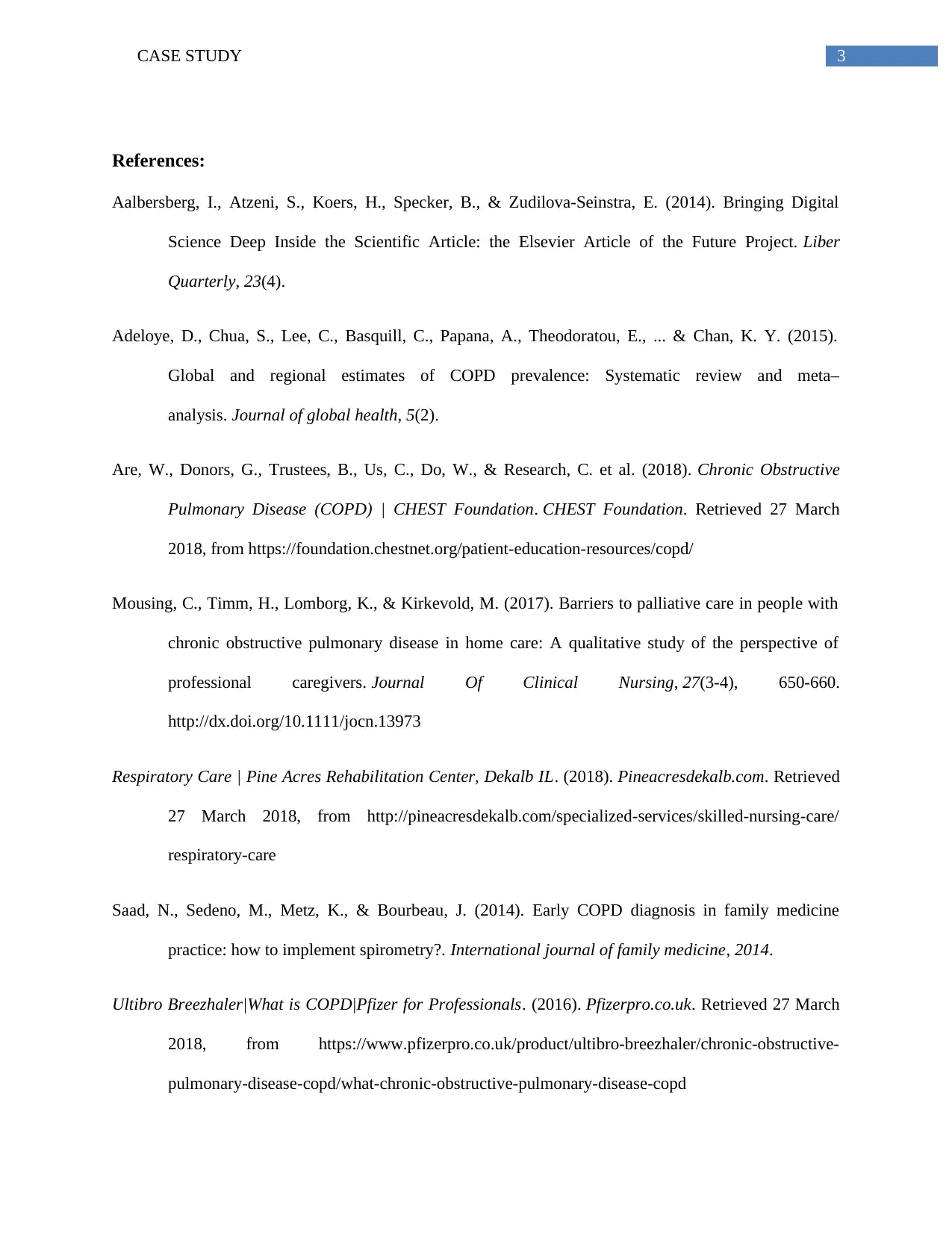
3CASE STUDY
References:
Aalbersberg, I., Atzeni, S., Koers, H., Specker, B., & Zudilova-Seinstra, E. (2014). Bringing Digital
Science Deep Inside the Scientific Article: the Elsevier Article of the Future Project. Liber
Quarterly, 23(4).
Adeloye, D., Chua, S., Lee, C., Basquill, C., Papana, A., Theodoratou, E., ... & Chan, K. Y. (2015).
Global and regional estimates of COPD prevalence: Systematic review and meta–
analysis. Journal of global health, 5(2).
Are, W., Donors, G., Trustees, B., Us, C., Do, W., & Research, C. et al. (2018). Chronic Obstructive
Pulmonary Disease (COPD) | CHEST Foundation. CHEST Foundation. Retrieved 27 March
2018, from https://foundation.chestnet.org/patient-education-resources/copd/
Mousing, C., Timm, H., Lomborg, K., & Kirkevold, M. (2017). Barriers to palliative care in people with
chronic obstructive pulmonary disease in home care: A qualitative study of the perspective of
professional caregivers. Journal Of Clinical Nursing, 27(3-4), 650-660.
http://dx.doi.org/10.1111/jocn.13973
Respiratory Care | Pine Acres Rehabilitation Center, Dekalb IL. (2018). Pineacresdekalb.com. Retrieved
27 March 2018, from http://pineacresdekalb.com/specialized-services/skilled-nursing-care/
respiratory-care
Saad, N., Sedeno, M., Metz, K., & Bourbeau, J. (2014). Early COPD diagnosis in family medicine
practice: how to implement spirometry?. International journal of family medicine, 2014.
Ultibro Breezhaler|What is COPD|Pfizer for Professionals. (2016). Pfizerpro.co.uk. Retrieved 27 March
2018, from https://www.pfizerpro.co.uk/product/ultibro-breezhaler/chronic-obstructive-
pulmonary-disease-copd/what-chronic-obstructive-pulmonary-disease-copd
References:
Aalbersberg, I., Atzeni, S., Koers, H., Specker, B., & Zudilova-Seinstra, E. (2014). Bringing Digital
Science Deep Inside the Scientific Article: the Elsevier Article of the Future Project. Liber
Quarterly, 23(4).
Adeloye, D., Chua, S., Lee, C., Basquill, C., Papana, A., Theodoratou, E., ... & Chan, K. Y. (2015).
Global and regional estimates of COPD prevalence: Systematic review and meta–
analysis. Journal of global health, 5(2).
Are, W., Donors, G., Trustees, B., Us, C., Do, W., & Research, C. et al. (2018). Chronic Obstructive
Pulmonary Disease (COPD) | CHEST Foundation. CHEST Foundation. Retrieved 27 March
2018, from https://foundation.chestnet.org/patient-education-resources/copd/
Mousing, C., Timm, H., Lomborg, K., & Kirkevold, M. (2017). Barriers to palliative care in people with
chronic obstructive pulmonary disease in home care: A qualitative study of the perspective of
professional caregivers. Journal Of Clinical Nursing, 27(3-4), 650-660.
http://dx.doi.org/10.1111/jocn.13973
Respiratory Care | Pine Acres Rehabilitation Center, Dekalb IL. (2018). Pineacresdekalb.com. Retrieved
27 March 2018, from http://pineacresdekalb.com/specialized-services/skilled-nursing-care/
respiratory-care
Saad, N., Sedeno, M., Metz, K., & Bourbeau, J. (2014). Early COPD diagnosis in family medicine
practice: how to implement spirometry?. International journal of family medicine, 2014.
Ultibro Breezhaler|What is COPD|Pfizer for Professionals. (2016). Pfizerpro.co.uk. Retrieved 27 March
2018, from https://www.pfizerpro.co.uk/product/ultibro-breezhaler/chronic-obstructive-
pulmonary-disease-copd/what-chronic-obstructive-pulmonary-disease-copd
Paraphrase This Document
Need a fresh take? Get an instant paraphrase of this document with our AI Paraphraser
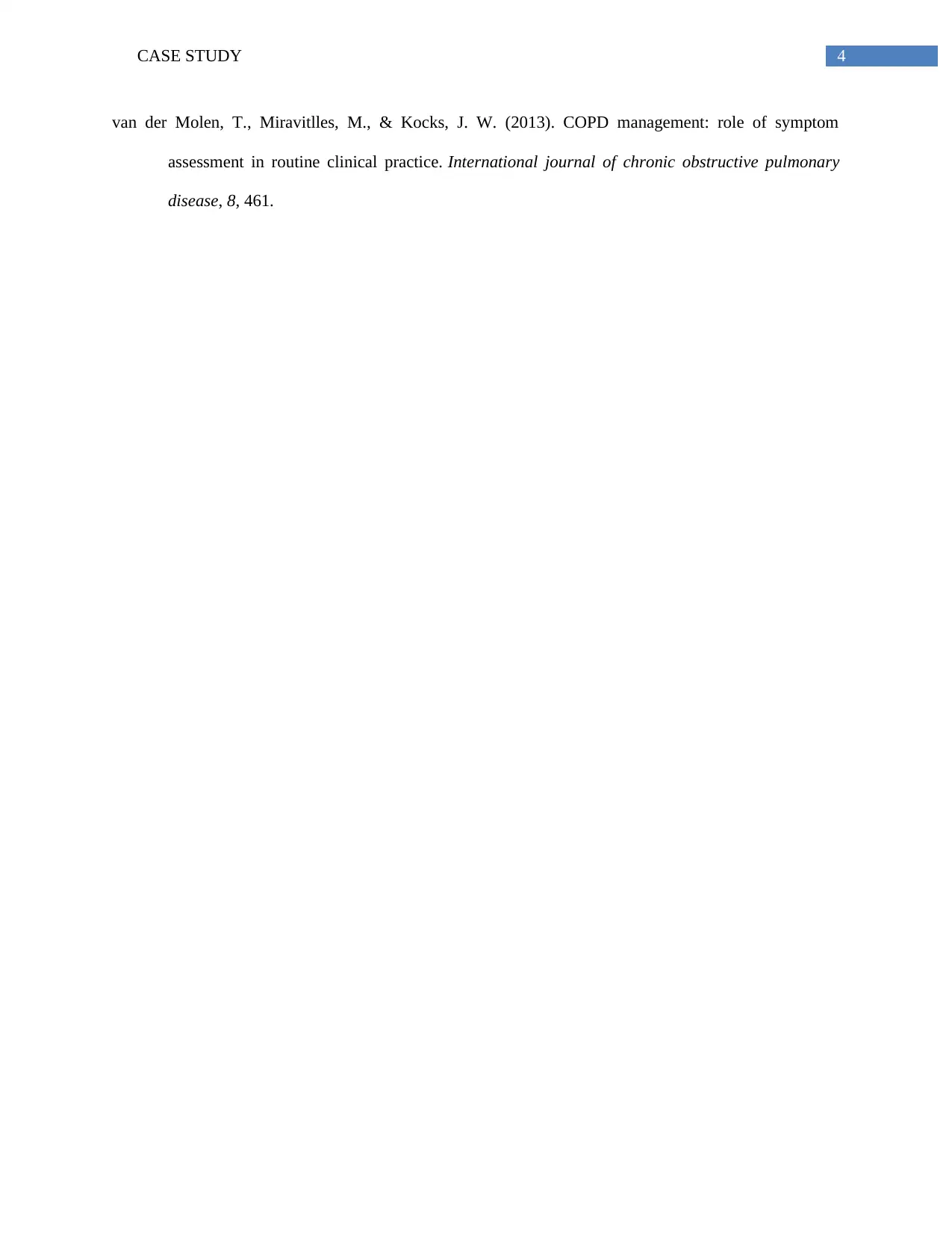
4CASE STUDY
van der Molen, T., Miravitlles, M., & Kocks, J. W. (2013). COPD management: role of symptom
assessment in routine clinical practice. International journal of chronic obstructive pulmonary
disease, 8, 461.
van der Molen, T., Miravitlles, M., & Kocks, J. W. (2013). COPD management: role of symptom
assessment in routine clinical practice. International journal of chronic obstructive pulmonary
disease, 8, 461.
1 out of 5
Related Documents
Your All-in-One AI-Powered Toolkit for Academic Success.
+13062052269
info@desklib.com
Available 24*7 on WhatsApp / Email
![[object Object]](/_next/static/media/star-bottom.7253800d.svg)
Unlock your academic potential
Copyright © 2020–2025 A2Z Services. All Rights Reserved. Developed and managed by ZUCOL.





